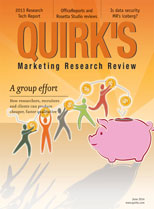Editor’s note: Dave Fish is responsible for global marketing and product development at Maritz Research, St. Louis. This is an edited version of a blog post that originally appeared here under the title “A simple CEM challenge.”
As CEM professionals, market researchers and data scientists, we sometimes get caught up in and enamored with the powerful analytics that are at our disposal. We can quickly run advanced multivariate, Bayesian, neural network, machine learning algorithms and thousands of other advanced analytical techniques with the click of a few buttons to instantaneously reduce millions of people into neat categories and models. Big data seems to be the buzzword of the day, with companies trying to understand specific customer preferences for specific locations and customers, with the goal of learning what side of the bed you sleep on in order to ensure proper location of the remote control and alarm clock. While big data hasn’t lived up to the hype to date, when it is done right it is good for the customer because it creates a better experience. But however good we get at big data analytics there is still a need to really understand consumers. We ratchet down and get closer to this understanding through the measurement of evaluations and attitudes; understanding the whys behind the whats. Even still, without understanding the context of behaviors and attitudes we are still flying a bit blind.
Now, qualitative work certainly assists with this issue. Long the “deep” to quantitative’s “wide,” qualitative research methods certainly have their place in CEM. Focus groups continue to be very popular. I always found it interesting that I could show a franchisee 50 survey responses from customers that highlighted a problem, with some very pointed comments to boot, but it wasn’t until I got him behind the glass and his customers started talking about his people and products that he became very engaged in the issue. At that point it turned real and personal. He grew very motivated, which is an excellent reason to do qualitative in the first place. But even with traditional qualitative approaches there is a contrived artificiality that is introduced that might not get you to the real truths. That one-way mirror at times has the effect of influencing what is and isn’t said.
Rather than sitting behind the desk and looking at numbers and reports in your CEM system, it always pays to go out and see what exactly is going on. Not only does this provide color and context, it gets you in touch with the folks you are suppose to be helping and delighting – your customers.
There is no substitute for seeing it with your own eyes. Go out and experience that hotel lobby or how you are greeted at check-in. Understand the culture and location in which the interaction is happening and the type of people who are participating. It is the difference between trading e-mails with a colleague and going out and having a beer with him. You just get a much richer experience.
When I worked for a Japanese firm years ago they called it genchi genbutsu, which roughly means “Go, look and confirm.” There is something to be learned from that.
Whenever I am in a customer experience setting (a bank, a restaurant, a dealership) I try to be a focused observer. What things are happening that might take away or add to an experience? What things aren’t happening? What things would people want that could make the experience even better? I make it habit (much to my wife’s embarrassment) to ask many questions wherever I am at when I see things that are going well or poorly with the customer experience. How do you handle complaints? How do you assure consistent service? How do they queue traffic and keep people informed?
